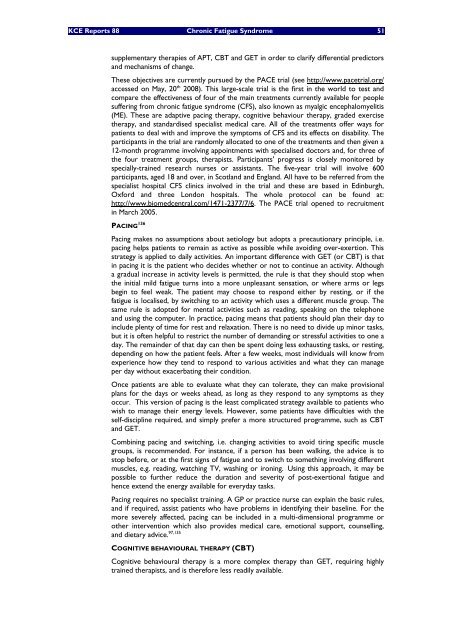Chronisch Vermoeidheidssyndroom: diagnose, behandeling en ...
Chronisch Vermoeidheidssyndroom: diagnose, behandeling en ...
Chronisch Vermoeidheidssyndroom: diagnose, behandeling en ...
Create successful ePaper yourself
Turn your PDF publications into a flip-book with our unique Google optimized e-Paper software.
KCE Reports 88 Chronic Fatigue Syndrome 51<br />
supplem<strong>en</strong>tary therapies of APT, CBT and GET in order to clarify differ<strong>en</strong>tial predictors<br />
and mechanisms of change.<br />
These objectives are curr<strong>en</strong>tly pursued by the PACE trial (see http://www.pacetrial.org/<br />
accessed on May, 20 th 2008). This large-scale trial is the first in the world to test and<br />
compare the effectiv<strong>en</strong>ess of four of the main treatm<strong>en</strong>ts curr<strong>en</strong>tly available for people<br />
suffering from chronic fatigue syndrome (CFS), also known as myalgic <strong>en</strong>cephalomyelitis<br />
(ME). These are adaptive pacing therapy, cognitive behaviour therapy, graded exercise<br />
therapy, and standardised specialist medical care. All of the treatm<strong>en</strong>ts offer ways for<br />
pati<strong>en</strong>ts to deal with and improve the symptoms of CFS and its effects on disability. The<br />
participants in the trial are randomly allocated to one of the treatm<strong>en</strong>ts and th<strong>en</strong> giv<strong>en</strong> a<br />
12-month programme involving appointm<strong>en</strong>ts with specialised doctors and, for three of<br />
the four treatm<strong>en</strong>t groups, therapists. Participants' progress is closely monitored by<br />
specially-trained research nurses or assistants. The five-year trial will involve 600<br />
participants, aged 18 and over, in Scotland and England. All have to be referred from the<br />
specialist hospital CFS clinics involved in the trial and these are based in Edinburgh,<br />
Oxford and three London hospitals. The whole protocol can be found at:<br />
http://www.biomedc<strong>en</strong>tral.com/1471-2377/7/6. The PACE trial op<strong>en</strong>ed to recruitm<strong>en</strong>t<br />
in March 2005.<br />
PACING 136<br />
Pacing makes no assumptions about aetiology but adopts a precautionary principle, i.e.<br />
pacing helps pati<strong>en</strong>ts to remain as active as possible while avoiding over-exertion. This<br />
strategy is applied to daily activities. An important differ<strong>en</strong>ce with GET (or CBT) is that<br />
in pacing it is the pati<strong>en</strong>t who decides whether or not to continue an activity. Although<br />
a gradual increase in activity levels is permitted, the rule is that they should stop wh<strong>en</strong><br />
the initial mild fatigue turns into a more unpleasant s<strong>en</strong>sation, or where arms or legs<br />
begin to feel weak. The pati<strong>en</strong>t may choose to respond either by resting, or if the<br />
fatigue is localised, by switching to an activity which uses a differ<strong>en</strong>t muscle group. The<br />
same rule is adopted for m<strong>en</strong>tal activities such as reading, speaking on the telephone<br />
and using the computer. In practice, pacing means that pati<strong>en</strong>ts should plan their day to<br />
include pl<strong>en</strong>ty of time for rest and relaxation. There is no need to divide up minor tasks,<br />
but it is oft<strong>en</strong> helpful to restrict the number of demanding or stressful activities to one a<br />
day. The remainder of that day can th<strong>en</strong> be sp<strong>en</strong>t doing less exhausting tasks, or resting,<br />
dep<strong>en</strong>ding on how the pati<strong>en</strong>t feels. After a few weeks, most individuals will know from<br />
experi<strong>en</strong>ce how they t<strong>en</strong>d to respond to various activities and what they can manage<br />
per day without exacerbating their condition.<br />
Once pati<strong>en</strong>ts are able to evaluate what they can tolerate, they can make provisional<br />
plans for the days or weeks ahead, as long as they respond to any symptoms as they<br />
occur. This version of pacing is the least complicated strategy available to pati<strong>en</strong>ts who<br />
wish to manage their <strong>en</strong>ergy levels. However, some pati<strong>en</strong>ts have difficulties with the<br />
self-discipline required, and simply prefer a more structured programme, such as CBT<br />
and GET.<br />
Combining pacing and switching, i.e. changing activities to avoid tiring specific muscle<br />
groups, is recomm<strong>en</strong>ded. For instance, if a person has be<strong>en</strong> walking, the advice is to<br />
stop before, or at the first signs of fatigue and to switch to something involving differ<strong>en</strong>t<br />
muscles, e.g. reading, watching TV, washing or ironing. Using this approach, it may be<br />
possible to further reduce the duration and severity of post-exertional fatigue and<br />
h<strong>en</strong>ce ext<strong>en</strong>d the <strong>en</strong>ergy available for everyday tasks.<br />
Pacing requires no specialist training. A GP or practice nurse can explain the basic rules,<br />
and if required, assist pati<strong>en</strong>ts who have problems in id<strong>en</strong>tifying their baseline. For the<br />
more severely affected, pacing can be included in a multi-dim<strong>en</strong>sional programme or<br />
other interv<strong>en</strong>tion which also provides medical care, emotional support, counselling,<br />
and dietary advice. 97,135<br />
COGNITIVE BEHAVIOURAL THERAPY (CBT)<br />
Cognitive behavioural therapy is a more complex therapy than GET, requiring highly<br />
trained therapists, and is therefore less readily available.

















